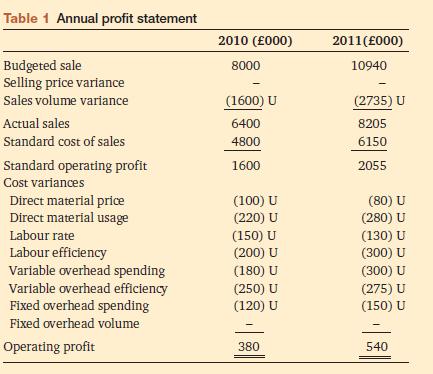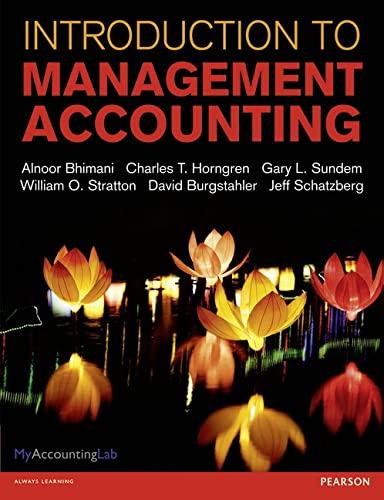This case is concerned with the use of ROI to measure divisional performance. It also addresses the
Question:
This case is concerned with the use of ROI to measure divisional performance. It also addresses the use of an integrated standard costing system to produce meaningful profit statements where standard setting is problematic.
The board of Zeros plc assesses divisional performance within the company primarily on the basis of a return-on-investment ratio. This is computed as follows:

The figure of operating profit is obtained from a standard-costing-based profit statement (see Table 1 for the two recent such statements).
Table 1

The Blank Division
In terms of turnover the Blank Division is the second largest division within the company. The divisional manager is Joe Cool who has worked in the division for over 30 years, initially as a management accountant and then as manager from 2001. He is 63 years old and will retire in 18 months’ time. In accordance with a board policy introduced to improve motivation at divisional level, his current remuneration contains a substantial bonus element based on divisional operating profit. In addition, his retirement pension will be based upon his average total earnings in his last three working years.
The Blank Division was resituated in a town-centre freehold site which was purchased in 1995. A custom-built factory was erected on the site with considerable financial aid from the government and was equipped with what were, at the time, the most modern machines available.
It is a matter of considerable pride to Joe that much of this equipment has been conscientiously maintained and is still in use today. In the accounting records the freehold site and factory building are still valued at historic cost.
The Blank Division produces a wide range of sizes of surgical needles, although all are sold at a standard price (see Table 2). Although the market is growing the competition is intense, being based on both price and, particularly, product quality.
Standard costs are revised at the start of each financial year (see Table 2) and are based on the middle-range size of surgical needle produced in the division.
It is frequently pointed out at board meetings by Joe Cool that the Blank Division can still achieve a 33 per cent mark-up on its standard unit cost and that no competing firm can approach this level of margin.
Table 2

In recent years the Blank Division has produced highly satisfactory return-on-investment figures and a reasonable profit growth. The board has, however, been concerned by the large unfavourable variances which have been consistently reported. The normal retort of the Blank Division manager to queries on the size of variances has been the state unequivocally that ‘it is the bottom line that matters; if that’s OK you can forget the rest’. He has also consistently promoted the performance of the division during 2010 and 2011 to the board as ‘excellent’ and rebuffed any judgements to the contrary. Results for the last two years are given in Table 1 and Table 3.
Table 1

Table 3

Questions
1. What criticism would you make of the approach to divisional-performance assessment employed by the board of Zeros plc?
2. Would you agree with Joe Cool’s assessment that his division’s performance was ‘excellent’ during 2010 and 2011?
3. What suggestions would you make for improving the divisional-performance measurement in Zeros plc?
Step by Step Answer:

Introduction To Management Accounting
ISBN: 9780273737551
1st Edition
Authors: Alnoor Bhimani, Charles T. Horngren, Gary L. Sundem, William O. Stratton, Jeff Schatzberg





